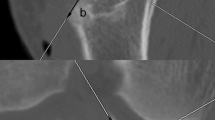Abstract
The purpose of this study is to compare the local microfracture effects of antegrade versus retrograde drilling of the tibial tunnel in ACL reconstruction. Arthroscopic ACL excision was performed on eight matched cadaveric knees. Arthroscopic guided tibial tunnel reaming was performed in either an antegrade (four) or retrograde (four) direction. A 3 × 3 cm section of proximal tibial surrounding the tibial aperture was removed with open dissection, and each section underwent micro-computed tomography analysis. Three musculoskeletal radiologists graded the specimens for bone aperture disruption and discrete fracture lines. Tibial aperture irregularity was seen in all four of the antegrade specimens (mean, Grade 1.5), and in none of the retrograde specimens. Discrete fracture lines were present in all four antegrade specimens (mean 10.13 mm depth; 8.95 mm length). No fracture lines were seen in the retrograde group. Retrograde drilling of the tibial tunnel in ACL reconstruction results in less microfracture trauma to the surrounding aperture bone. The use of retrograde drilling in ACL reconstruction may decrease synovialization of the graft-tissue interface when compared to antegrade drilling.



Similar content being viewed by others
References
Aglietti P, Giron F, Buzzi R et al (2004) Anterior cruciate ligament reconstruction: bone-patellar tendon-bone compared with double semitendinosis and gracilis tendon grafts. A prospective, randomized clinical trial. J Bone Joint Surg Am 86:2143–2155
Barber FA, Spruill B, Sheluga M (2003) The effect of outlet fixation on tunnel widening. Arthrosc 19:485–492
Berg EE, Pollard ME, Kang Q (2001) Interarticular bone tunnel healing. Arthrosc 17:189–195
Freedman KB, D’Amato MJ, Nedeff DD et al (2003) Arthroscopic anterior cruciate ligament reconstruction: a meta-analysis comparing patellar tendon and hamstring tendon autografts. Am J Sports Med 31:2–11
Hoher J, Moller HD, Fu FH (1998) Bone tunnel enlargement after anterior cruciate ligament reconstruction: fact or fiction? Knee Surg Sports Traumatol Arthrosc 6:231–240
Ishibashi Y, Rudy TW, Livesay GA et al (1997) The effect of anterior cruciate ligament graft fixation site at the tibia on knee stability: evaluation using a robotic system. Arthrosc 13:177–182
Lubowitz JH (2006) No tunnel anterior cruciate ligament reconstruction. Arthrosc 22:900e1–900e11
Morgan CD, Kalman VR, Grawl DM (1995) Definitive landmarks for reproducible tibial tunnel placement in anterior cruciate ligament reconstruction. Arthrosc 11:275–288
Morgan CD, Stein DA, Leitman EH, et al (2002) Anatomic tibial graft fixation using a retrograde bio-interference screw for endoscopic anterior cruciate ligament reconstruction. Arthrosc 18:38e1–38e8
Rodeo SA, Kawamura S, Kim H et al (2006) Tendon healing in a bone tunnel differs at the tunnel entrance versus the tunnel exit: an effect of graft-tunnel motion? Am J Sports Med 34:1790–1800
Weiler A, Hoffmann RFG, Bail HJ, et al (2002) Tendon healing in a bone tunnel. Part II: histologic analysis after biodegradable interference fit fixation in a model of anterior cruciate ligament reconstruction in sheep. Arthrosc 18:124–135
Acknowledgments
Research was supported by Arthrex, Naples, FL. The authors acknowledge Pacific Medical Inc., (Tracy, CA), for the donation of cadaveric specimens used in this study and use of the Arthrex (Naples, FL) retrodrill system.
Conflict of interest
The authors report no conflict of interest.
Author information
Authors and Affiliations
Corresponding author
Rights and permissions
About this article
Cite this article
McAdams, T.R., Biswal, S., Stevens, K.J. et al. Tibial aperture bone disruption after retrograde versus antegrade tibial tunnel drilling: a cadaveric study. Knee Surg Sports Traumatol Arthr 16, 818–822 (2008). https://doi.org/10.1007/s00167-008-0554-6
Received:
Accepted:
Published:
Issue Date:
DOI: https://doi.org/10.1007/s00167-008-0554-6




